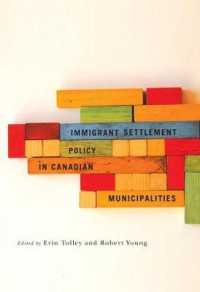- ホーム
- > 洋書
- > ドイツ書
- > Humanities, Arts & Music
- > History
- > prehistory
基本説明
New in softcover. Hardcover was published in 2006. As the third volume in the Andean Archaeology set, the focus is on the strong cultural differences between the northern and southern regions of the Central Andes and to consider the under which differences evolved and which were diminished.
Full Description
Andean Archaeology III represents a continuation in our effort to highlight the ?nest of current archaeological scholarship conducted in the Central Andean c- ture area. Each paper contributes in a signi?cant way to understanding prehistoric processes in the Central Andean culture tradition, adding importantly to the rich base provided by Andean Archaeology I and II. As in those former volumes we do not seek a balanced presentation of the entirety of the Andean past, but instead showcase what is new, what is innovative, and what is controversial in thinking about and investigating the great sweep of Andean cultural development. We wholeheartedly agree with Pauketat (2001:xiii) that it is "more satisfying to compare how cultural phenomena happened," than for researchers to hasten to answer "why questions" that tend more to "reify their initial assumptions" than to inform us about prehistoric people and their embodied, cultural practices. We supporttherevitalizedstudyofsocioculturalevolution,especiallythatchampioned by Bruce Trigger (e.g., 1998, 2003), which has bene?ted by several decades of valuable critique. Ontheotherhand,explanationsofthepastnotbasedoncomparisonsofhistorical processes carefully argued from well-studied archaeological records sacri?ce the rigor that was such an important part of the ?rst processual archaeology advocated byLewisBinford(1962,1964,1972;Sabloff1998;seealsoYoffee2005interalia). In some recent and current Andean archaeology we ?nd explanatory conclusions, especiallyprocessualevolutionarytransformations,andclimatechange-basedrise or collapse accounts, to have been reached too hastily, constituting more of a reading of material remains in terms of theoretical expectations than a rigorous interrogation of thearchaeological record.
Contents
Regional Patterns.- The North.- America's First City? The Case of Late Archaic Caral.- Religious Warfare at Chankillo.- The Vicús-Mochica Relationship.- Competitive Feasting, Religious Pluralism and Decentralized Power in the Late Moche Period.- Northern Exposures: Recuay-Cajamarca Boundaries and Interaction.- Chimu Craft Specialization and Political Economy: A View from the Provinces.- The South.- Early Village Society in the Formative Period in the Southern Lake Titicaca Basin.- The Emergence of Complex Society in the Titicaca Basin: The View from the North.- Redefining Plant Use at the Formative Site of Chiripa in the Southern Titicaca Basin.- Ritual and Society in Early Intermediate Period Ayacucho: A View From the Site of Ñawinpukyo.- Missing Links, Imaginary Links: Staff God Imagery in the South Andean Past.- Water, Blood and Semen: Signs of Life and Fertility in Nasca Art.- Burial Patterns and Sociopolitical Organization in Nasca 5 Society.- When and Where Did the Nasca Proliferous Style Emerge?.- Violence and Rural Lifeways at Two Peripheral Wari Sites in the Majes Valley of Southern Peru.- Suspension Bridges of the Inca Empire.- Conclusion.- Rethinking the Central Andean Co-Tradition.






